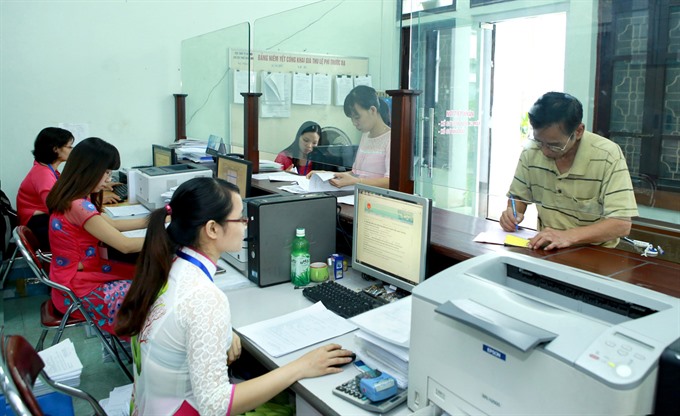 Economy
Economy

The Government will submit a tax reduction plan to the National Assembly (NA) this month, which aims to meet targets of increasing the number of efficient enterprises in the country to one million by 2020.
 |
| Businesses pay taxes at Đan Phượng District’s Tax Department. The finance ministry proposes to cut corporate income tax for SMEs and start-ups from the current 20 per cent to 17 per cent between 2017 and 2020. - VNA/VNS Photo Hoàng Hùng |
HÀ NỘI – The Government will submit a tax reduction plan to the National Assembly (NA) this month, which aims to meet targets of increasing the number of efficient enterprises in the country to one million by 2020.
Phạm Đình Thi, director of Ministry of Finance’s Tax Policy Department, said the tax reduction plan was part of a Government draft resolution on clearing obstacles to boost the development of enterprises, which would be tabled during the NA’s second session that starts on October 20.
Under the draft plan, the finance ministry proposes to cut corporate income tax for small- and medium-sized enterprises (SMEs) as well as start-ups from the current 20 per cent to 17 per cent between 2017 and 2020.
Thi estimated that the tax reduction would lead to an insignificant drop in State budget revenues. It would reduce by approximately VNĐ473 billion (US$21.11 million) per year if based on the current Law on Corporate Income Tax, according to which firms with a turnover of less than VNĐ20 billion per year were exempted from the tax. The revenue drop would be as much as VNĐ1.5 trillion per year if the draft Law on Support for Small- and Medium-sized Enterprises was passed as it decrees that firms with turnover of less than VNĐ100 billion were exempted from the tax.
"However, if the tax cut policy is approved, it will ensure that there are thousands of newly established enterprises every year," Thi said. "The contribution of these new firms to the State budget will help offset the revenue drop and over time will increase the State budget revenue."
So far, to meet the target of increasing the number of efficient enterprises in the country to one million, the Government has issued a resolution on supporting and developing firms till 2020 and asked the Ministry of Planning and Investment to create a law that supports the growth of SMEs.
In the draft resolution, the finance ministry also proposes to allow enterprises to use profits from their real estate projects to offset losses in other industries and sectors. Thi said the Government wanted to encourage firms to invest in agriculture, a vulnerable sector because of its dependence on the weather. The proposal to allow the use of profits from real estate projects to offset losses in other sectors would encourage companies to invest in the agriculture.
Đặng Đức Thành, chairman of HCM City Economists Club and member of the Việt Nam Chamber of Commerce and Industry (VCCI)’s Executive Committee, said meeting the one-million target by 2020 would be tough. To do that, he said, the country needed the comprehensive and thorough participation of all ministries, sectors and localities so as to build a conducive business environment that would create a start-up revolution in Việt Nam.
Besides building a favourable business environment, Thành recommended that the Government should encourage competitiveness by supporting the set-up of co-operation chains. Firms themselves, however, also would have to restructure to become more competitive, he said.
As per statistics from the VCCI’s Việt Nam Annual Business Report 2015, there were around 513,000 firms in Việt Nam at the end of 2015, which is very low when compared with the country’s population of more than 90 million. To meet the world’s average ratio, Việt Nam needs to have two million operational firms, VCCI said.
Besides, the existing companies are also not doing well -- of the 513,000 firms, only 42 per cent made profits; the remaining broke even or make losses.
The number of firms that had to shut down in the first nine months of this year was 8,365, up 20.2 per cent year-on-year, shows data from the Ministry of Planning and Investment’s Business Registration Management Agency. Most of these firms are small, with a registered capital of less than VNĐ10 billion each. - VNS



.jpg)
